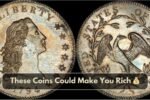Ever found a dusty old penny in your drawer and thought, “This might be worth something”? You’re not alone. A lot of us dream of finding hidden treasure in our spare change. But here’s the wild part—some pennies from the 1900s are now worth over a million dollars. Yep, that little coin could be your golden ticket (or copper ticket, if you will).
So, what makes these pennies so valuable? It usually comes down to rare mistakes, limited minting, or unusual metals. Let’s dive into five rare pennies from the 1900s that collectors would pay big bucks to get their hands on.
1909-S VDB Lincoln Cent
This one’s like the holy grail of pennies. It was the first year the Lincoln penny was made, and it had the designer’s initials “V.D.B.” on the back. But some people didn’t like that, so the mint quickly removed them. Only a few were made with the initials and the “S” mint mark from San Francisco.
Why it’s valuable: Low mintage (only about 484,000) and those controversial initials make it rare. If you’ve got one in perfect shape, it could be worth over a million!
| Feature | Detail |
| Year | 1909 |
| Mint Mark | S (San Francisco) |
| Special Mark | V.D.B. on reverse |
| Estimated Value | $1,000,000+ (for top grade) |
1943 Bronze Lincoln Cent
Now here’s a penny that was never supposed to exist. In 1943, because of World War II, the U.S. started making pennies out of steel to save copper for the war effort. But a few copper blanks got stuck in the machines from 1942 and were accidentally stamped in 1943.
Why it’s valuable: It’s a mint mistake and only a handful were made. That oops turned into a million-dollar jackpot for lucky collectors.
| Feature | Detail |
| Year | 1943 |
| Material | Bronze (not steel) |
| Mint Error | Yes |
| Estimated Value | $1,000,000+ (depending on condition) |
1914-D Lincoln Penny
This one’s a sneaky rare coin. At first glance, it looks pretty normal. But that small “D” under the date, which stands for the Denver mint, makes all the difference. The 1914-D penny had a super low mintage, and not many were kept in good condition.
Why it’s valuable: Fewer than 1.2 million were made, and most are well-worn. A shiny, top-quality one? That’s where the money’s at.
1926-S Lincoln Penny
This penny is rare not because of a mistake, but because it was just really hard to find a good one. The San Francisco mint didn’t make many that year, and the ones that were made usually weren’t well-struck.
Why it’s valuable: A clean, well-preserved 1926-S penny can fetch big money at auctions. Some have sold for six figures, and the very best ones get close to the million-dollar mark.
1958 Doubled Die Obverse Penny
Ever seen a penny where the letters look doubled? That’s called a “doubled die” and it’s a collector’s dream. The 1958 version is extremely rare. Only a few are known to exist.
Why it’s valuable: This type of mint error is super dramatic. You can clearly see the doubling with your eyes. Plus, there are probably fewer than five of these floating around. That’s why it could easily break the million-dollar ceiling.
Conclusion
Who knew that a small copper coin in your pocket could be worth more than a house? These rare pennies from the 1900s prove that sometimes, the most ordinary-looking things can have the biggest hidden value. Whether it’s a strange error or a short production run, each of these coins has a story—and collectors are more than willing to pay top dollar for a piece of that history.
So next time you’re digging through an old jar of coins, keep an eye out. You might just find a penny that could change your life.
FAQs
Can I still find these rare pennies in circulation?
It’s very unlikely, but not impossible. Most of these rare coins are already in collections.
How do I know if my penny is valuable?
Look for unique features like mint marks, errors, and dates. You can also get it checked by a coin expert.
Where can I sell a rare penny?
Auction houses, coin dealers, and even online platforms like eBay are good places to start.
What does “mint condition” mean?
It means the coin is in excellent shape—just like when it was first made.
Are old pennies always valuable?
Not always. Age helps, but rarity, condition, and special features matter more.





